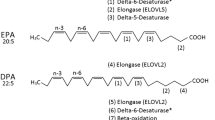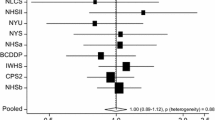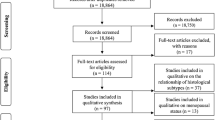Abstract
Objectives
Limited experimental evidence suggests that omega-3 polyunsaturated (n-3) fatty acids inhibit the proliferation of ovarian cancer cells in vitro, whereas omega-6 polyunsaturated (n-6) fatty acids have been shown to promote carcinogenesis, but epidemiological studies to date have been inconclusive. Our aim was to evaluate the role of polyunsaturated fatty acids in ovarian carcinogenesis.
Methods
Participants in the Australian Ovarian Cancer Study (1,366 cases and 1,414 population controls) self-completed risk factor and food frequency questionnaires. Logistic regression models were used to calculate adjusted odds ratio (OR) and 95 % confidence intervals (CI).
Results
We found no association between intake of total n-3 fatty acids from foods, or the individual n-3 fatty acids—alpha-linolenic, eicosapentaenoic, docosapentaenoic, docosahexaenoic acids—and ovarian cancer risk. High intake of total n-6 fatty acids was inversely associated with risk (OR for highest vs. lowest category 0.78, 95 % CI 0.60–1.00, p-trend 0.04); however, the association was restricted to n-6 fatty acids from avocado, vegetables, and nuts. Neither higher intake of the individual n-6 fatty acids nor the ratio of n-3 to n-6 fatty acids was associated with ovarian cancer risk. We found no evidence that risk varied by supplement use.
Conclusions
Our data provide no evidence of a protective role for n-3 fatty acids in ovarian carcinogenesis. The benefit, if any, of higher intake of n-6 fatty acids is due to general properties of the food sources, rather than due to the n-6 fatty acids per se.
Similar content being viewed by others
References
Howlader N, Noone AM, Krapcho M, Neyman N, Aminou R, Waldron W et al. (2011) SEER Cancer Statistics Review, 1975–2008. http://seer.cancer.gov/csr/1975_2008/. Accessed on 22 March 2012
Adami H-O, Hunter D (2008) Textbook of cancer epidemiology. University Press, Oxford
Huncharek M, Kupelnick B (2001) Dietary fat intake and risk of epithelial ovarian cancer: a meta-analysis of 6,689 subjects from 8 observational studies. Nutr Cancer 40(2):87–91. doi:10.1207/S15327914NC402_2
Genkinger JM, Hunter DJ, Spiegelman D, Anderson KE, Beeson WL, Buring JE et al (2006) A pooled analysis of 12 cohort studies of dietary fat, cholesterol and egg intake and ovarian cancer. Cancer Causes Control 17(3):273–285. doi:10.1007/s10552-005-0455-7
Rose DP, Connolly JM, Coleman M (1996) Effect of omega-3 fatty acids on the progression of metastases after the surgical excision of human breast cancer cell solid tumors growing in nude mice. Clin Cancer Res 2(10):1751–1756
Rose DP, Connolly JM (1993) Effects of dietary omega-3 fatty acids on human breast cancer growth and metastases in nude mice. J Natl Cancer Inst 85(21):1743–1747
Rose DP, Connolly JM (1999) Omega-3 fatty acids as cancer chemopreventive agents. Pharmacol Ther 83(3):217–244
Cockbain AJ, Toogood GJ, Hull MA (2012) Omega-3 polyunsaturated fatty acids for the treatment and prevention of colorectal cancer. Gut 61(1):135–149. doi:10.1136/gut.2010.233718
Sharma A, Belna J, Espat J, Rodriguez G, Cannon VT, Hurteau JA (2009) Effects of omega-3 fatty acids on components of the transforming growth factor beta-1 pathway: implication for dietary modification and prevention in ovarian cancer. Am J Obstet Gynecol 200(5):516 e511–516 e516. doi:10.1016/j.ajog.2008.12.023
Sharma A, Belna J, Logan J, Espat J, Hurteau JA (2005) The effects of Omega-3 fatty acids on growth regulation of epithelial ovarian cancer cell lines. Gynecol Oncol 99(1):58–64. doi:10.1016/j.ygyno.2005.05.024
Ansenberger K, Richards C, Zhuge Y, Barua A, Bahr JM, Luborsky JL, Hales DB (2010) Decreased severity of ovarian cancer and increased survival in hens fed a flaxseed-enriched diet for 1 year. Gynecol Oncol 117(2):341–347. doi:10.1016/j.ygyno.2010.01.021
Fay MP, Freedman LS, Clifford CK, Midthune DN (1997) Effect of different types and amounts of fat on the development of mammary tumors in rodents: a review. Cancer Res 57(18):3979–3988
Rose DP (1997) Effects of dietary fatty acids on breast and prostate cancers: evidence from in vitro experiments and animal studies. Am J Clin Nutr 66(6 suppl):1513S–1522S
MacLean CH, Newberry SJ, Mojica WA, Khanna P, Issa AM, Suttorp MJ, Lim YW, Traina SB, Hilton L, Garland R, Morton SC (2006) Effects of omega-3 fatty acids on cancer risk: a systematic review. JAMA 295(4):403–415. doi:10.1001/jama.295.4.403
Hooper, L, Thompson RL, Harrison RA, Summerbell CD, Ness AR, Moore HJ, Worthington HV, Durrington PN, Higgins JP, Capps NE, Riemersma RA, Ebrahim SB, Davey Smith G (2006) Risks and benefits of omega 3 fats for mortality, cardiovascular disease, and cancer: systematic review. BMJ 332(7544):752–760. doi:10.1136/bmj.38755.366331.2F
Blank MM, Wentzensen N, Murphy MA, Hollenbeck A, Park Y (2012) Dietary fat intake and risk of ovarian cancer in the NIH-AARP diet and health study. Br J Cancer 106(3):596–602. doi:10.1038/bjc.2011.572
Tavani A, Pelucchi C, Parpinel M, Negri E, Franceschi S, Levi F et al (2003) n-3 polyunsaturated fatty acid intake and cancer risk in Italy and Switzerland. Int J Cancer 105(1):113–116. doi:10.1002/ijc.11018
Bidoli E, La Vecchia C, Montella M, Maso LD, Conti E, Negri E et al (2002) Nutrient intake and ovarian cancer: an Italian case-control study. Cancer Causes Control 13(3):255–261
Bertone ER, Rosner BA, Hunter DJ, Stampfer MJ, Speizer FE, Colditz GA et al (2002) Dietary fat intake and ovarian cancer in a cohort of US women. Am J Epidemiol 156(1):22–31
Merritt MA, Green AC, Nagle CM, Webb PM (2008) Talcum powder, chronic pelvic inflammation and NSAIDs in relation to risk of epithelial ovarian cancer. Int J Cancer 122(1):170–176. doi:10.1002/ijc.23017
Willett W, Sampson L, Stampfer MJ, Rosner B, Bain C, Witschi J et al (1985) Reproducibility and validity of a semiquantitative food frequency questionnaire. Am J Epidemiol 122:51–65
McNaughton SA, Mishra GD, Brunner EJ (2007) Validation of a FFQ to estimate the intake of PUFA using plasma phospholipid fatty acids and weighed foods records. Br J Nutr 97(3):561–568. doi:10.1017/S0007114509243030
Ibiebele TI, Parekh S, Mallitt KA, Hughes MC, O’Rourke PK, Webb PM (2009) Reproducibility of food and nutrient intake estimates using a semi-quantitative FFQ in Australian adults. Public Health Nutr 12(12):2359–2365. doi:10.1017/S1368980009005023
Mann N, Sinclair A, Percival P, Lewis J, Meyer B (2003) Development of a database of fatty acids in Australian foods. Nutr Diet 60(1):42–45
Ashton BA, Ambrosini GL, Marks GC, Harvey PW, Bain C (1997) Development of a dietary supplement database. Aust N Z J Public Health 21(7):699–702
World Health Organisation (2000) Obesity: preventing and managing the global epidemic-report of a WHO Consultation on Obesity. WHO Technical Report Series (no. 894). Geneva, Switzerland
Marks GC, Hughes MC, van der Pols JC (2006) Relative validity of food intake estimates using a food frequency questionnaire is associated with sex, age, and other personal characteristics. J Nutr 136(2):459–465
Signori C, El-Bayoumy K, Russo J, Thompson HJ, Richie JP, Hartman TJ, Manni A (2011) Chemoprevention of breast cancer by fish oil in preclinical models: trials and tribulations. Cancer Res 71(19):6091–6096. doi:10.1158/0008-5472.CAN-11-0977
Acknowledgments
Full membership of the Australian Ovarian Cancer Study Group is listed at http://www.aocstudy.org/; the Australian Cancer Study Investigators are A. Green, P. Parsons, N. Hayward, P. Webb, and D. Whiteman. We gratefully acknowledge the support and assistance of the Survey of Women’s Health study research group and the cooperation of the following institutions: New South Wales: John Hunter Hospital, North Shore Private Hospital, Royal Hospital for Women, Royal North Shore Hospital, Royal Prince Alfred Hospital, Westmead Hospital, and New South Wales Cancer Registry; Queensland: Mater Misericordiae Hospital, Royal Brisbane and Women’s Hospital, Townsville Hospital, Wesley Hospital, and Queensland Cancer Registry; South Australia: Flinders Medical Centre, Queen Elizabeth II, Royal Adelaide Hospital, and South Australian Cancer Registry; Tasmania: Royal Hobart Hospital; Victoria: Freemasons Hospital, Mercy Hospital For Women, Monash Medical Centre, Royal Women’s Hospital, and Victorian Cancer Registry; Western Australia: King Edward Memorial Hospital, St. John of God Hospitals Subiaco, Sir Charles Gairdner Hospital, Western Australia Research Tissue Network (WARTN), and Western Australia Cancer Registry. We acknowledge Ms. Maria Celia Hughes from the Queensland Institute of Medical Research for preparation of the dietary data and Nirmala Pandeya of the Queensland Institute of Medical Research for her statistical advice, and we would like to thank all of the women who participated in the study. The Australian Ovarian Cancer Study was supported by the U.S. Army Medical Research and Materiel Command [grant no DAMD17-01-1-0729], the Cancer Council Tasmania, and Cancer Foundation of Western Australia. The Australian Cancer Study was supported by the National Health and Medical Research Council of Australia [grant no 199600]. The National Health and Medical Research Council of Australia supports P.M Webb and C.M. Nagle.
Conflict of interest
The authors declare no conflict of interests.
Author information
Authors and Affiliations
Corresponding author
Additional information
T. I. Ibiebele and C. M. Nagle are joint first authors.
This study was conducted for the Australian Ovarian Cancer Study Group.
Electronic supplementary material
Below is the link to the electronic supplementary material.
Rights and permissions
About this article
Cite this article
Ibiebele, T.I., Nagle, C.M., Bain, C.J. et al. Intake of omega-3 and omega-6 fatty acids and risk of ovarian cancer. Cancer Causes Control 23, 1775–1783 (2012). https://doi.org/10.1007/s10552-012-0053-4
Received:
Accepted:
Published:
Issue Date:
DOI: https://doi.org/10.1007/s10552-012-0053-4




